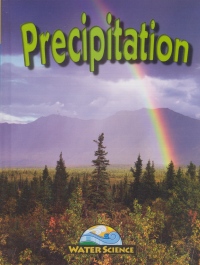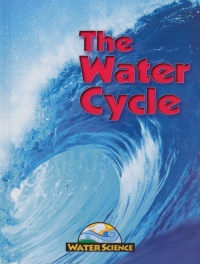| ________________
CM . . . . Volume XVII Number 30 . . . . April 8, 2011
excerpt:
Though the six-volume "Water Science" series is designed for elementary school-aged readers, it could (and should) also be advertised as a terrific timesaver for teachers. Linking print with media is the concept behind the series which is part of the AV² Media Enhanced Books. According to the publishers, AV² books "provide readers with access to enriched and enhanced content." Each book in this series has 12 chapters that include topics such as the formation and types of the featured form of water, its concentration in various parts of the world, its history, and the people who study it. Near the back of the book are eight facts about the topic, brainteasers which test the reader's comprehension of the text, and the instructions for a simple science experiment related to the topic. "Eco notes" also appear throughout the book, providing additional information. (Only one minor flaw in the books: they all begin with "Eco notes" instead of starting with the main body of the text. Perhaps these two pages should be switched.) Although the text is fairly easy for readers to comprehend, some of the concepts are slightly more complex than others. Illustrations include colour photos, charts, diagrams, timelines and maps. A table of contents, a list of words to know and an index are provided. The final page offers an explanation of how the AV² aspect of the series works. Here, readers will find the various symbols, common throughout the various series, that can be found online and which will describe a specific type of activity- an audio link, a video, a web link or an activity. In order to use the AV² option, readers must have access to the Internet. On the second page of the book, there is a URL as well as a title-specific book code that they must enter once they get to the home page. As a further security measure, readers must find a particular word in the book and type it in the box provided. For example, what is the last word of the third paragraph on page 11? These directions seem a bit cumbersome, but once students arrive at the title's enhanced content, they are rewarded with a great deal of extra information about the topic that they are researching. There are brief audio clips with a read-along option, several short video clips which range from one minute to just over six minutes, downloadable worksheets (creative writing activities, matching activities, maps, comprehension questions, etc) and a slide show. Web links provide plenty of information as well. Each of these choices is linked to a specific double-page spread in the book. The only minor drawbacks of the AV² option are the two-step log in process and the slightly fuzzy picture quality of the videos. Generally, this marriage of print and electronic media is very timely and sure to appeal to the majority of readers (and teachers, too). Though there are no guarantees that the web links will remain constant, the publisher states that all of the media-enhanced books are monitored regularly to update URLs and web sites. By employing links to respected and reputable organizations and publications, such as the Virtual Museum of Canada, Scientific American, and the National Snow and Ice Data Center, to name a few, the publisher is effectively reducing the odds of having to change the links. Glaciers can be grouped by size or location and consist of three main zones- accumulation, ablation and equilibrium. They can change the landscape by gouging valleys, creating fjords and crevasses and forming horns or mountaintops. These and other topics can be found in Glaciers. Readers will learn about the formation and movement of glaciers, the work of a glaciologist, and terms such as cirques, arÍtes, medial moraines and truncated spurs. By using the AV² option, they can watch videos of a moving glacier, a glaciologist and the tools she uses in her work, and of scientists discussing future ice ages. Downloadable worksheets include a diagram of glacier zones, a map showing glaciers around the world, and a creative writing activity. One of the web links shows different types of glaciers. Precipitation covers an important part of the water cycle. Various forms of precipitation, types of storms (including a timeline of deadly storms), extremes in precipitation, such as monsoons, droughts and flash floods, and cloud seeding are highlighted. Cloud seeding, in particular, is a very interesting topic in that scientists are able to use technology to create storms or lessen their severity, and to control cloud formation near airports to ensure safe takeoffs and landings. Other topics include rainbows (this section is a bit complex), acid rain, and the work of a meteorologist. Readers can build a simple rain gauge out of a plastic soda bottle, marbles and water as an experiment. Some of the activities in the AV² links include a matching game, a word search, a writing activity which asks students to write the story of a water drop from the water drop's point of view, and a guided report on one of the storms mentioned in the timeline in the book. Videos show acid rain researchers in the Black Forest area of Germany, as well as the power of flash floods, while a web link offers questions and answers about the work of a meteorologist. The Water Cycle features information about the three states of water, different types of clouds, condensation and precipitation, the effects of pollution on the water cycle, and the work of a hydrologist, and introduces readers to terms such as water vapor, transpiration, evaporation, runoff and groundwater. There are diagrams of the water cycle and a map of the world showing the availability of fresh water. A quick and easy experiment in transpiration demonstrates whether leaves or evergreen needles give off more water. Using the AV² option, readers can watch videos about the water cycle and hydrologists, engage in a variety of activities, including the comparison of molecules in solids, liquids and gases, and, via web links, learn more detailed information about different types of clouds, forms of precipitation and the work of a hydrologist. An interactive diagram of the water cycle presents the concept in a fun manner. Well done, and definitely worthy of purchase! Highly Recommended. Gail Hamilton is Library Learning Resources Consultant at the Instructional Resources Unit, Manitoba Department of Education in Winnipeg, MB.
To comment
on this title or this review, send mail to cm@umanitoba.ca.
Copyright © the Manitoba Library Association. Reproduction for personal
use is permitted only if this copyright notice is maintained. Any
other reproduction is prohibited without permission.
NEXT REVIEW |
TABLE OF CONTENTS FOR THIS ISSUE
- April 8, 2011.
AUTHORS |
TITLES |
MEDIA REVIEWS |
PROFILES |
BACK ISSUES |
SEARCH |
CMARCHIVE |
HOME |


